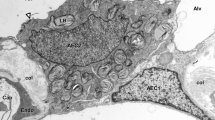Summary
The elastic fiber system in the human tracheal and bronchial mucosa was studied by light and electron microscopy. Elastic fibers, elaunin fibers, and oxytalan fibers were discerned. These fibers were identified by means of their staining characteristics (elastica stains, methods for disulfide-groups) and on account of their fine structural morphology. Elastic fibers consist of elastin and few “elastic-fiber microfibrils”. The relative amount of elastin (compared to the amount of elastic-fiber microfibrils) is large in elastic fibers but small in elaunin fibers. Oxytalan fibers — by contrast — are pure bundles of microfibrils.
In the light microscope a well-defined elastic lamina separates the lamina propria and the submucosa of the normal mucous membrane. The elastic lamina is formed by coarse strands of longitudinally running elastic fibers. A delicate network of elastica-positive fibers is attached to the basement membrane of the epithelial layer (subepithelial elastic layer). A few of these elastica-positive fibers branch out, traverse the region of the thickened basement membrane, and insert into the basal lamina of the epithelium. A loose network of elastica-positive fibers is present both in the lamina propria and in the submucosa. Plates of cartilage, glandular epithelium, and bundles of smooth muscle cells are enveloped by delicate elastica-positive fibers.
Electron microscopy shows the lamina elastica to be predominantly composed of elastic fibers, whilst elaunin fibers from the subepithelial elastic layer. Fibers penetrating the thickened basement membrane of the epithelium are identified as oxytalan fibers. All three types of fibers are present throughout the lamina porpria and in the submucosa. Elaunin fibers and oxytalan fibers comprise the elastica-positive nets around glandular epithelium, smooth muscle bundles, and cartilage. The preferred location of oxytalan fibers (within the thickened basement membrane), elaunin fibers (subepithelial elastica-positive layer), and clastic fibers (lamina elastica) facilitates the comparison of light microscopic staining reactions and fine structural morphology of these fibers.
Similar content being viewed by others
References
Albert EN, Fleischer E (1970) A new electron-dense stain for elastic tissue. J Histochem Cytochem 18:697–708
Bariéty M, Paillas J, Lévy M (1951) La trachée et les bronches cartilagineuses. Structure et fonctionnement des dispositives musculaires et élastiques. Masson, Paris
Böck P (1977) Staining of elastin and pseudo-elastica (“elastic fiber microfibrils”, type III and type IV collagen) with paraldehyde fuchsin. Mikroskopie 33:332–341
Böck P (1978) Histochemical staining of lymphatic anchoring filaments. Histochemistry 58:343–345
Böck P (1979) Elaunin fibers in the basement membrane of sweat gland secretory coil are rich in disulfide-groups. Experientia 35:538–539
Bradamante Z, Svajger A (1977) Pre-elastic (oxytalan) fibers in the developing elastic cartilage of the external ear of the rat. J Anat (Lond) 123:735–743
Carmichael GG, Fullmer HM (1966) The fine structure of the oxytalan fiber. J Cell Biol 28:33–36
Castino F, Bussolati G (1974) Thiosulfation for the histochemical demonstration of protein-bound sulphhydryl and disulphide groups. Histochemistry 39:93–96
Cotta-Pereira G, Rodrigo FG, Bittencourt-Sampaio S (1975) Ultrastructural study of elaunin fibers in the secretory coil of human excrine sweat glands. Brit J Derm 93:623–629
Cotta-Pereira G, Rodrigo FG, Bittencourt-Sampaio S (1976a) Oxytalan, elaunin, and elastic fibers in the human skin. J Invest Derm 66:143–148
Cotta-Pereira G, Rodrigo FG, David-Ferreira JF (1976b) The use of tannic acid-glutaraldehyde in the study of elastic and elasticrelated fibers. Stain Technol 51:7–11
Cotta-Pereira G, Rodrigo FG, David-Ferreira JF (1977) The elastic system fibers. In: Sandberg LB, Gray WR, Franzblau C (eds) Elastin and elastic tissue. Plenum Press, New York and London, pp 19–30
Fullmer HM, Sheez JH, Narkates AJ (1974) Oxytalan connective tissue fibers: a review. J Oral Pathol 3:291–316
Gabe M (1976) Histological techniques. Masson and Springer Verlag, New York
Gawlik Z (1965) Morphological and morphochemical properties of the elastic system in the motor organ of man. Folia Histochem Cytochem 3:233–245
Kádár A (1979) The elastic fiber. Ultrastructural studies of normal and pathological arteries. Experimental Pathol, Suppl 5
Kaissling B (1973) Histologische und histochemische Untersuchungen an semidünnen Schnitten. Gegenbaurs Morphol Jahrb 119:1–13
Kajikawara K, Yamaguchi T, Katsuda S, Miwa A (1975) An improved electron stain for elastic fibers using tannic acid. J Electr Micr 24:287–289
Pearse AGE (1968) Histochemistry. Theoretical and applied. 3rd ed, vol 1. J&A Churchill, London
Reynolds ES (1963) The use of lead citrate at high pH as an electron-opaque stain in electron microscopy. J Cell Biol 17:208–213
Romeis B (1968) Mikroskopische Technik 16th ed. R. Oldenburg-Verlag, München-Wien
Ross R (1973) The elastic fiber. A review. J Histochem Cytochem 21:199–208
Ross R, Bornstein P (1969) The elastic fiber. I. The separation and partial characterization of its macromolecular components. J Cell Biol 40:366–381
Sage H, Gray WR (1979) Studies on the evolution of elastin-I. Phylogenetic distribution. Comp Biochem Physiol B 64:313–327
Schaffer J (1933) Lehrbuch der Histologie und Histogenese, 3rd ed. Urban & Schwarzenberg, Berlin
Scott JE, Dorling J (1965) Differential staining of acid glycosaminoglycans (mucopolysaccharides) by alcian blue in salt solutions. Histochemie 5:221–233
Spicer SS, Lillie RD (1959) Saponification as a means of selectively reversing the methylation blockade of tissue basophilia. J Histochem Cytochem 7:123–125
Stockinger L (1974) Studies on elastic material in the human tracheal mucosa. Comparative bright and dark field illumination electron microscopy. Proc 8th Int Congr Electr Micr, Canberra, Vol, II, pp 470–471
Author information
Authors and Affiliations
Additional information
With financial support from the “Fonds zur Förderung der Wissenschaftlichen Forschung”, project Nr. 4055, and “Hochschuljubiläumsstiftung der Stadt Wien”. Part of this work has been presented at the” 2. Arbeitstagung der Anatomischen Gesellschaft”, Würzburg, 8.-10.10.1980
Rights and permissions
About this article
Cite this article
Böck, P., Stockinger, L. Light and electron microscopic identification of elastic, elaunin and oxytalan fibers in human tracheal and bronchial mucosa. Anat Embryol 170, 145–153 (1984). https://doi.org/10.1007/BF00318999
Accepted:
Issue Date:
DOI: https://doi.org/10.1007/BF00318999




